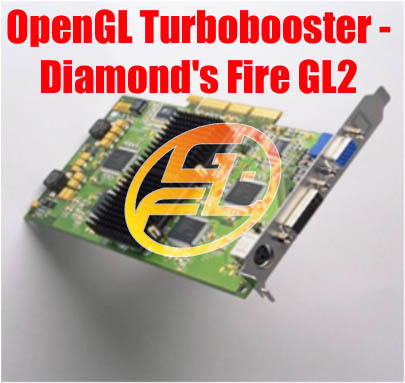OpenGL Turbobooster - Diamond's FireGL2
Introduction
Recently it seems as if NVIDIA has become pretty much omnipresent and almost omnipotent in each of the different graphics sectors, from the low-end/ high-end desktop to the workstation and mobile arena. However, NVIDIA has not managed to change the basic rules of the professional OpenGL-graphics market yet. Here, NVIDIA's short product cycles are neither necessary nor particularly welcome, because workstations are company investments that aren't supposed to get upgraded every half-year. Nobody really cares about fancy pixel or texel fill rates or features like FSAA and DX8-support either. The price of a professional OpenGL-card is not of major importance, because in the CAD-field the actual engineer is what is really costly and so those companies are willing to pay big money for whatever makes the work for their engineers easier and quicker.
Diamond's German-based professional OpenGL-group had already been one of the major developers of top-notch OpenGL-accelerators long before NVIDIA made its entry in the professional OpenGL-market with 'Quadro', a chip identical to GeForce, but running with a few different hardware switches and different drivers, which received its high performance from NVIDIA's by-the-time brand new integrated T&L-engine. The last chip in Diamond's long FireGL-line of products was the FireGL1-card, which had finally been beaten by NVIDIA's Quadro. Before the release of NVIDIA's first OpenGL-accelerator the FireGL1 had pretty much ruled the segment of midrange-priced professional OpenGL-cards, exclusively equipped with a chip designed and made by IBM. There's a cloak of secrecy and mysticism over this OpenGL-chip development group of IBM, which had remained pretty quiet until recently, when it finally launched a new line of chips that is again exclusively found on Diamond's new FireGL2-card. This new card seems well potent to challenge NVIDIA's latest professional OpenGL-solution by the name of 'Quadro 2 Pro', which is exclusively found on the Gloria III card from Elsa. Either solution comes at a retail price of about 1200 dollars.
The R&D teams of NVIDIA and Diamond's OpenGL-group are adherers of two completely different philosophies. NVIDIA, the uncontested leader in high-end graphics chips for the 3D desktop/gaming market, is using its latest chip variety to establish itself in the OpenGL workstation market. The Quadro2 Pro chip is mainly based on the GeForce2 GTS core but runs at higher clock speeds, uses faster memory and offers a few more (again hardware switched and software enabled) features.
Former exclusive partner ELSA decided to unite its graphic R&D team resources with NVIDIA. This means ELSA does not develop graphics cards by itself anymore but uses NVIDIA's reference designs instead. Elsa's and NVIDIA's workstation driver developers are cooperating as well. The Elsa's Gloria III card is basically the NVIDIA-designed Quadro2 Pro reference card.
The designers from Diamond's Starnberg/Bavaria-based professional OpenGL-group come from a different background. They are primarily focused on the OpenGL workstation market without paying any attention to 3D-gaming.
In this test we cared little about the politics of the abovementioned companies, but were merely interested in their current products. Thus, we have the FireGL2 compete with NVIDIA's Quadro2 Pro reference card (aka Elsa Gloria III). As we've already published test results of the Quadro2 Pro in previous articles (New NVIDIA Detonator 3 Drivers For Linux , NVIDIA 3D Under Linux ) and also use this card for the SpecViewperf benchmarks, we decided to focus on the features of Diamond's FireGL2.
Get Tom's Hardware's best news and in-depth reviews, straight to your inbox.

